An analysis of lexical cohesion of english and vietnamese economic news discourse
The main aim of this study is to search for the similarities and differences between English and
Vietnamese economic news with regard to the utilization of sub-types of lexical cohesion.
To fulfill this objective, ten pieces of English economic news and ten pieces of Vietnamese
economic news of equal types were selected, categorized, and analyzed based on the taxonomies
provided by Halliday and Hasan (1976). The percentages of sub-categories of lexical cohesion in
both English and Vietnamese economic news were calculated and the results were compared and
contrasted between and within text groups. The results obtained from the study indicated that the
overall features of English and Vietnamese economic news discourse in terms of lexical cohesion
are nearly the same - there is no significant difference in statistics between other lexical cohesive
devices in English and Vietnamese economic news. All types of lexical cohesive ties are employed
in this type of discourse of both English and Vietnamese. Moreover, the frequencies of occurrence
of subtypes of lexical reiteration decrease respectively in both English and Vietnamese.
The results of this study can be utilized as a basic theoretical description of lexical cohesion in
English and Vietnamese. Moreover, they can be of benefit as referential material for pedagogical
and translation.
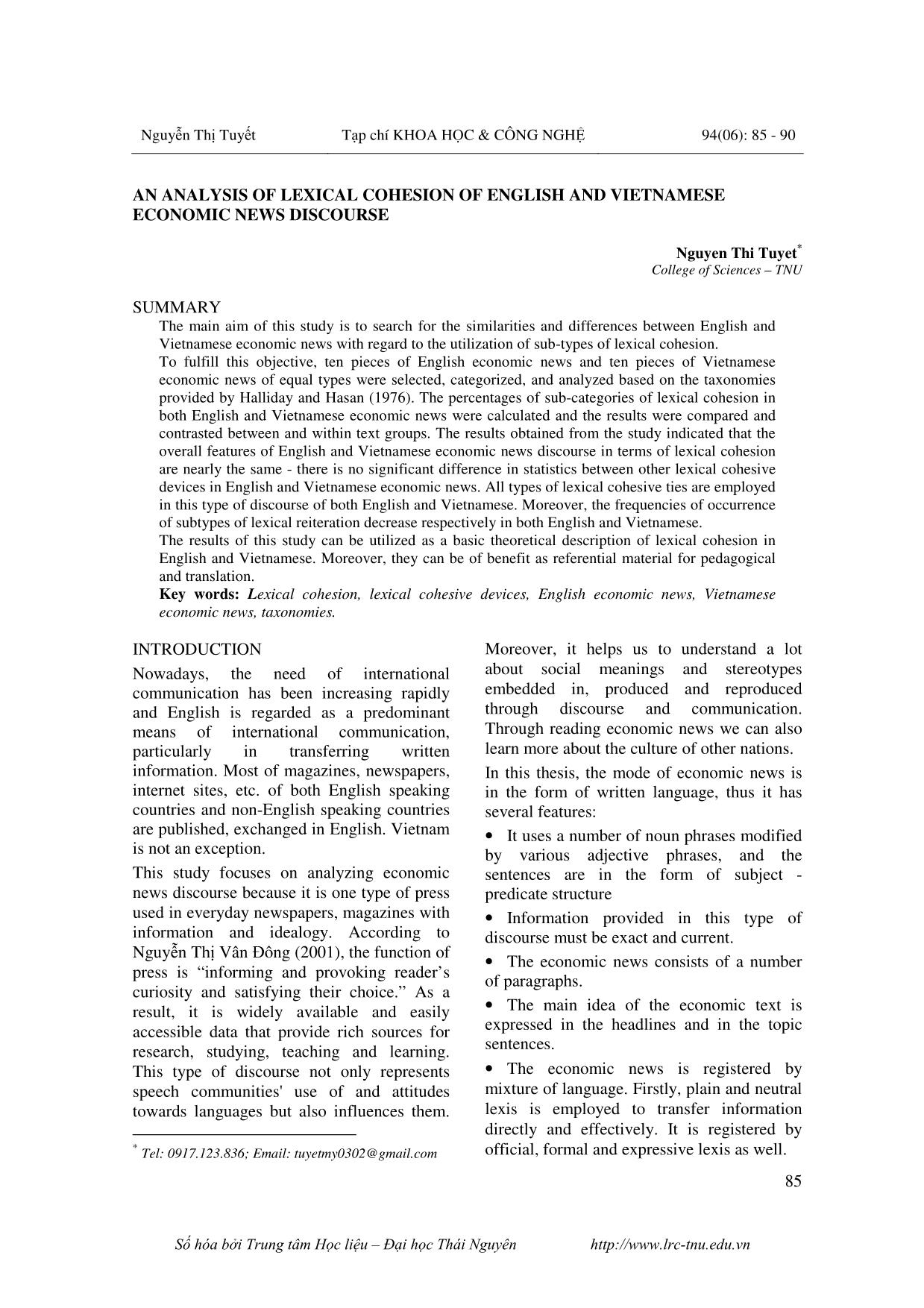
Trang 1
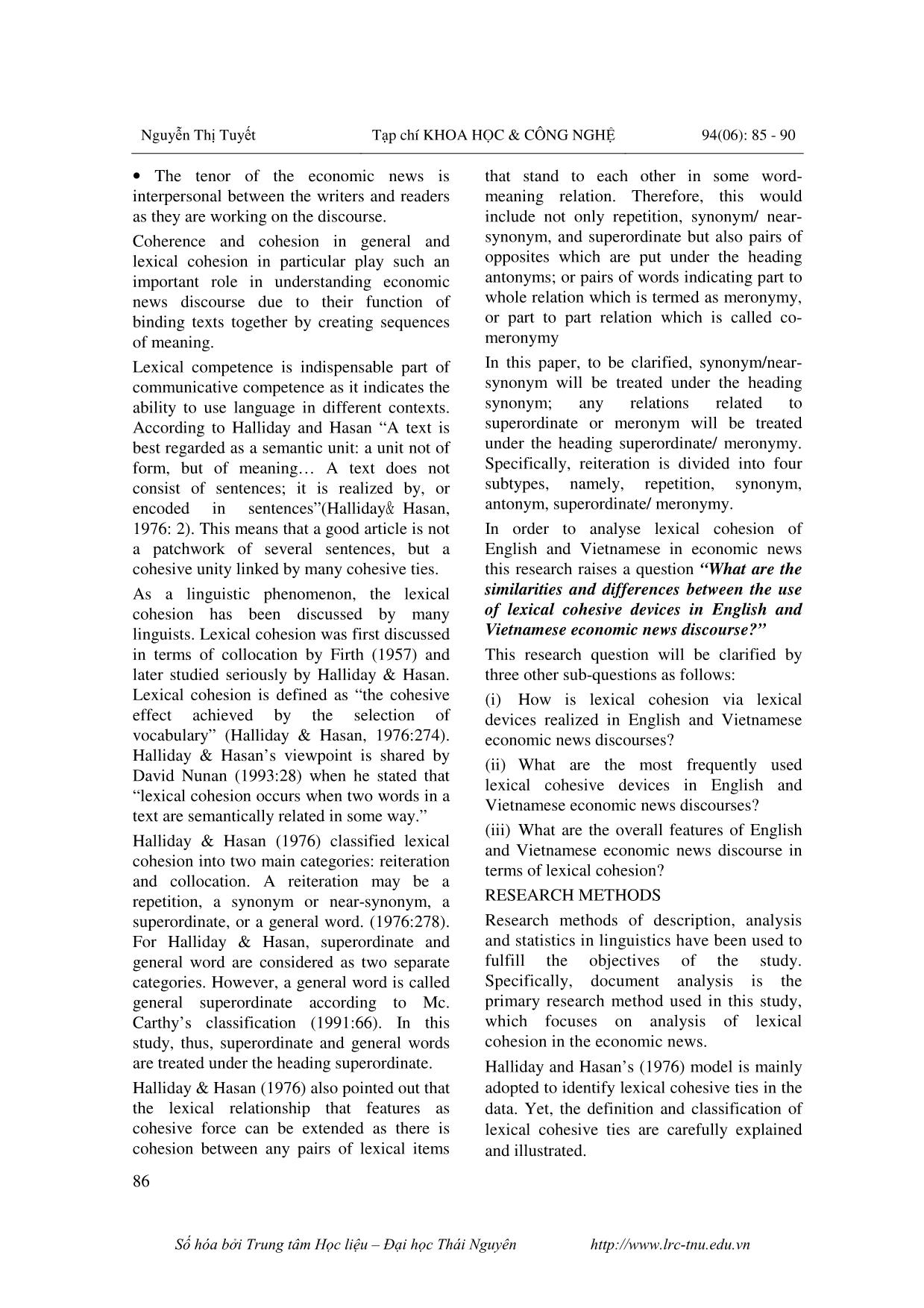
Trang 2
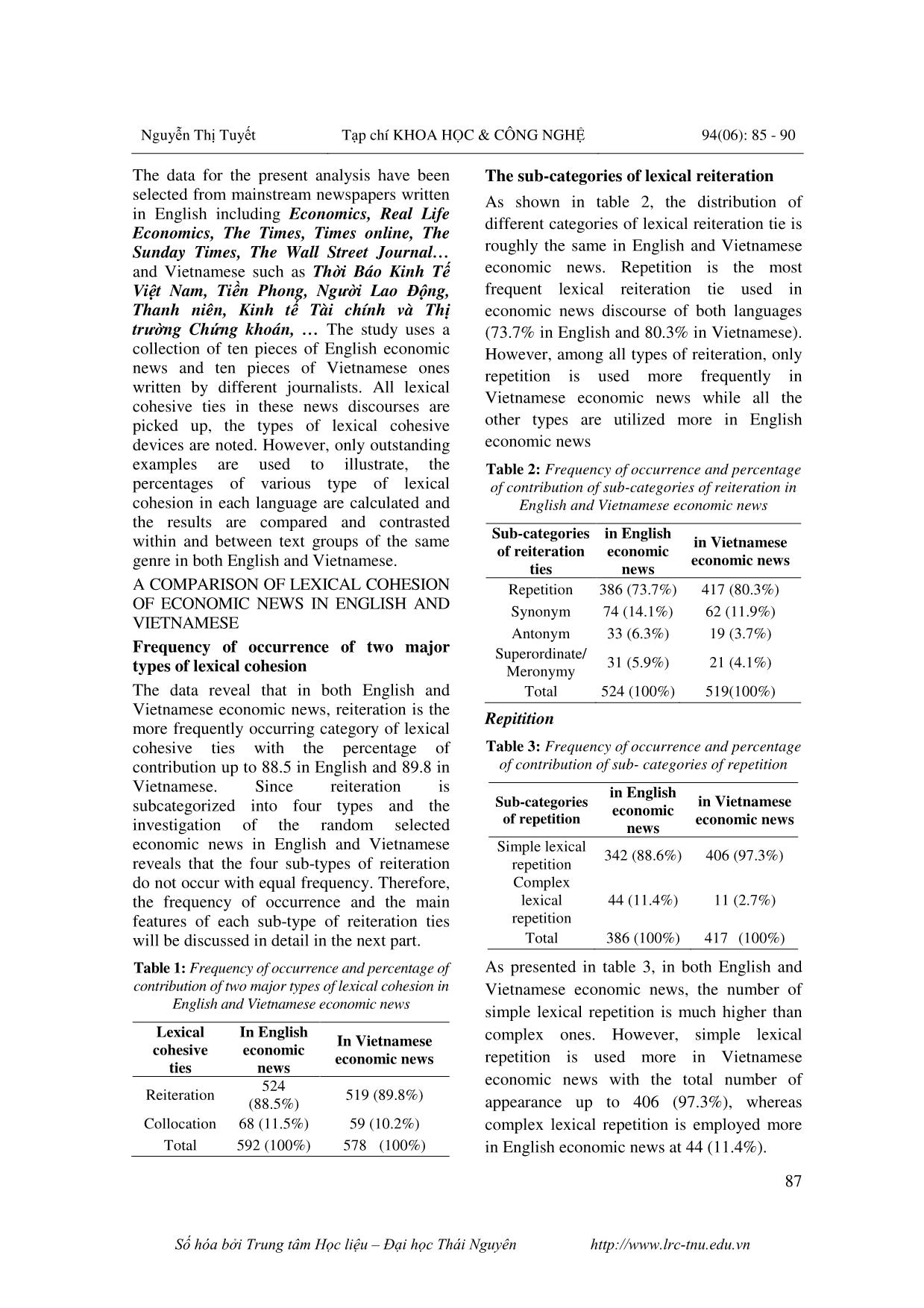
Trang 3
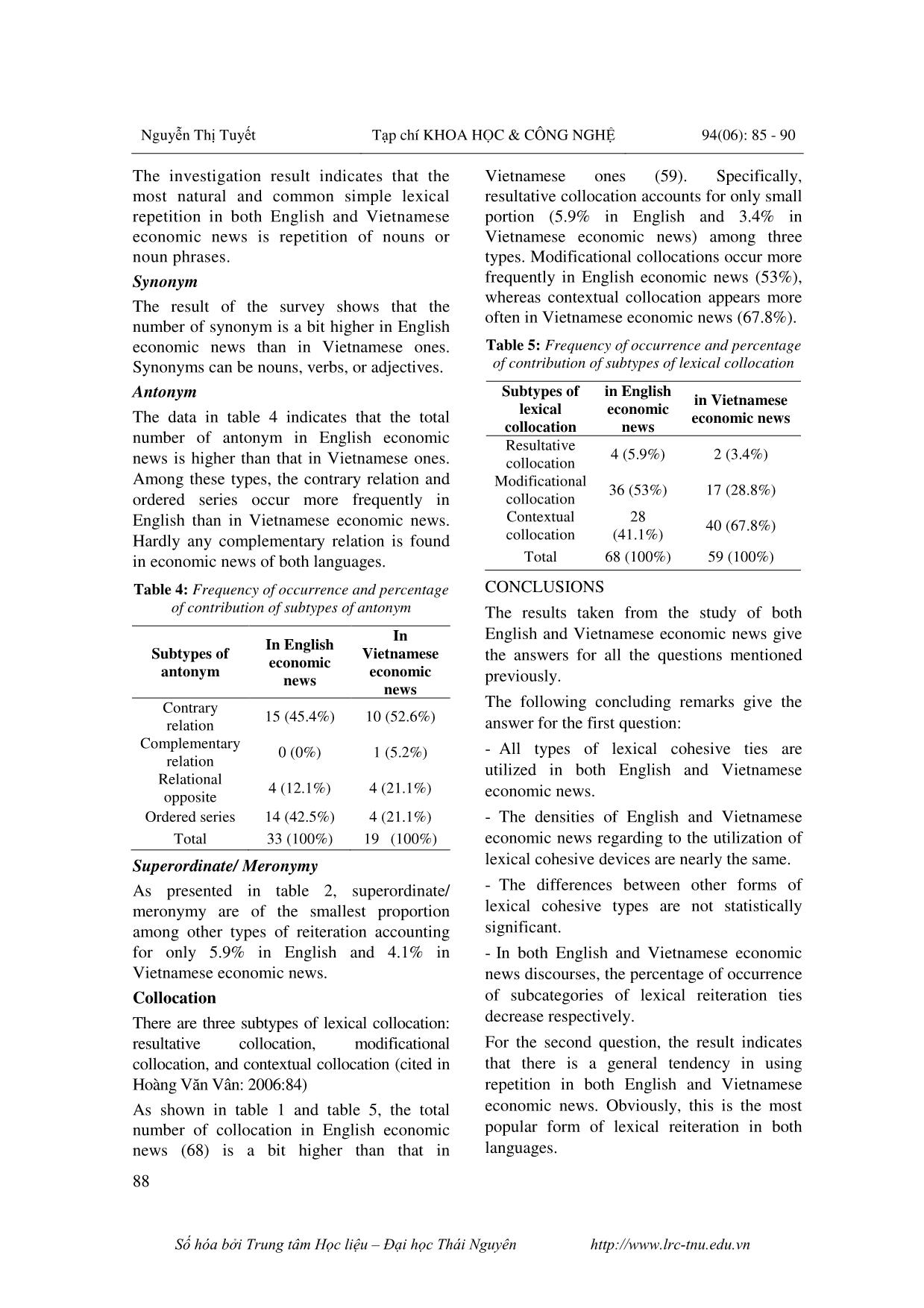
Trang 4
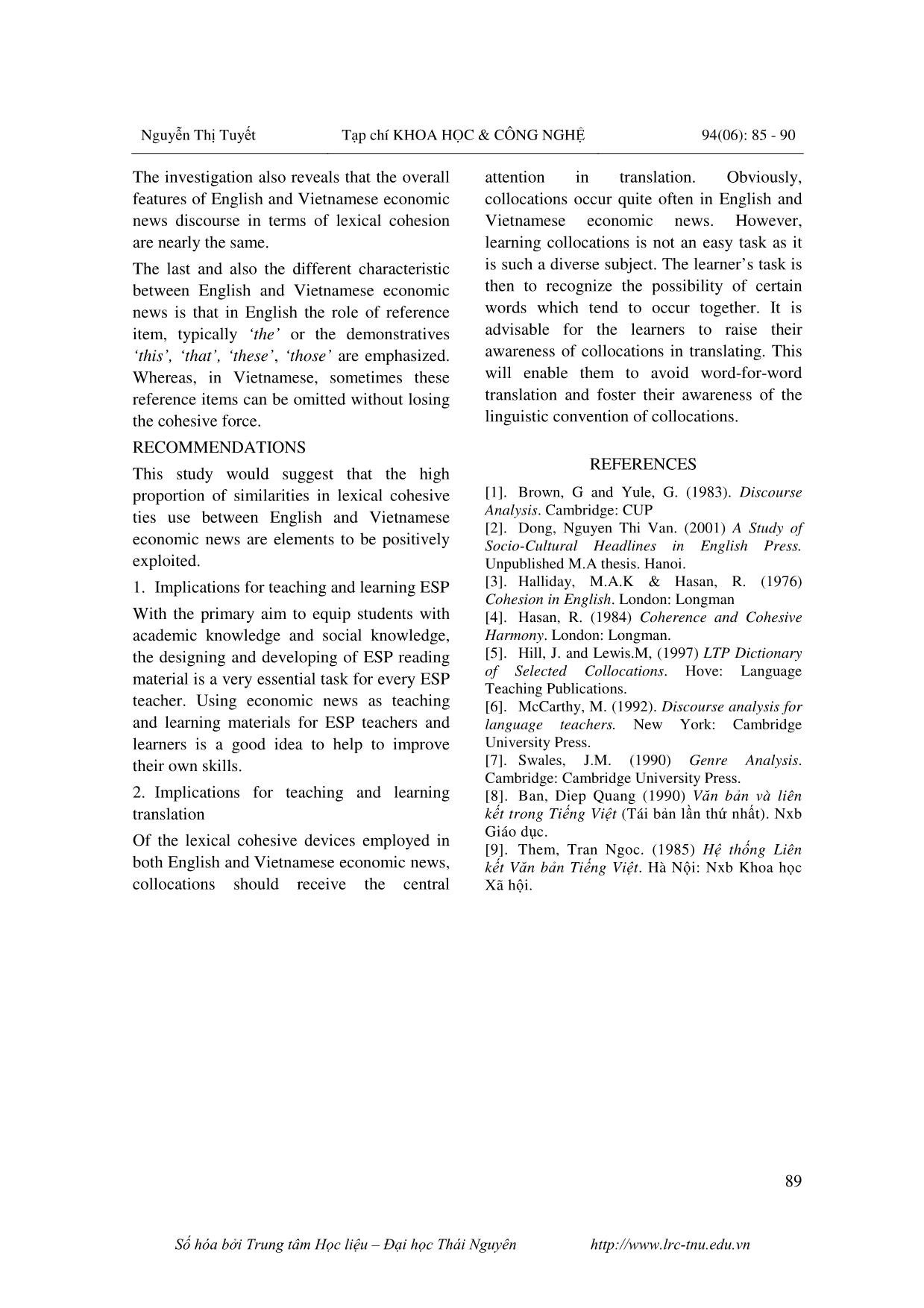
Trang 5
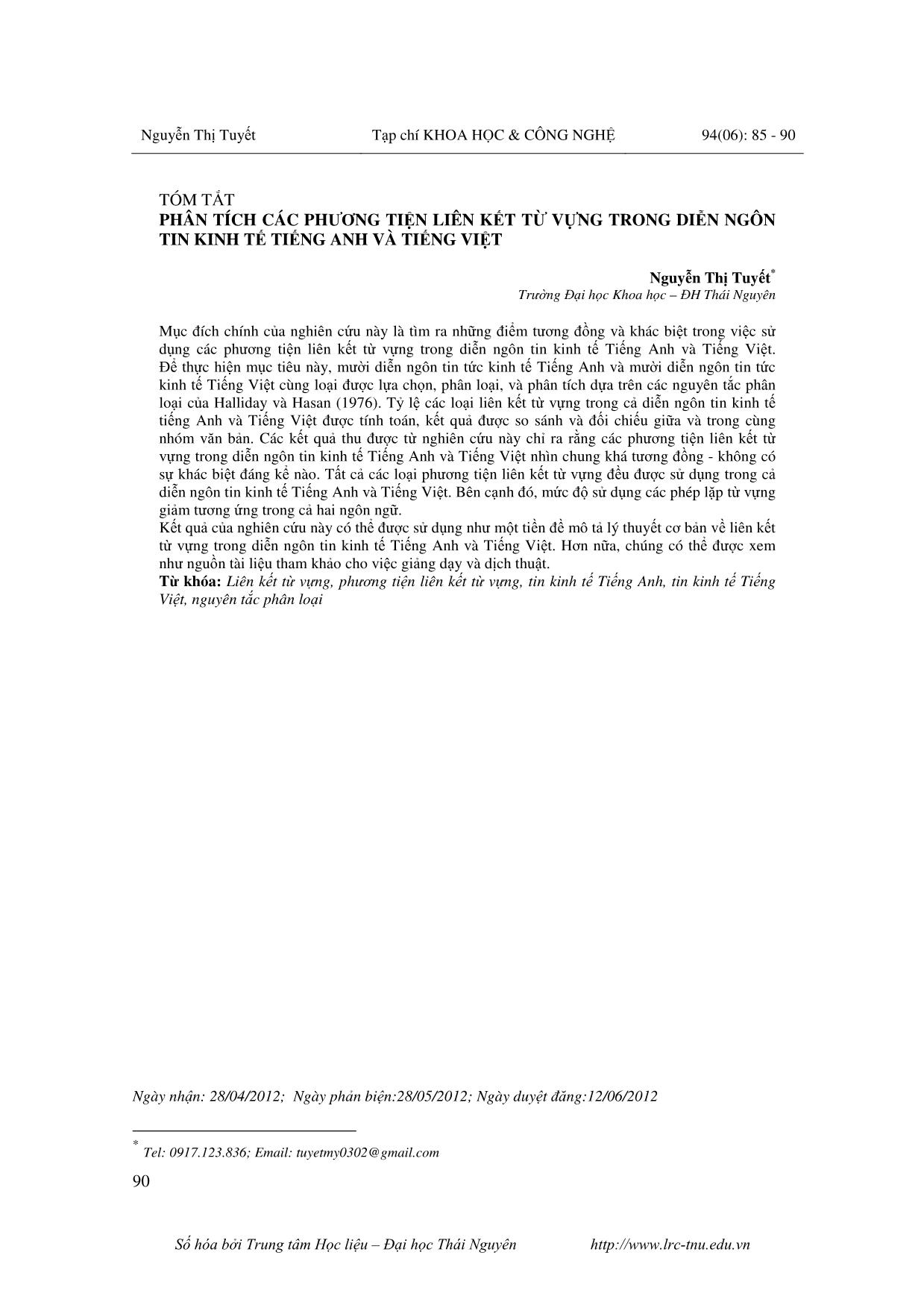
Trang 6
Tóm tắt nội dung tài liệu: An analysis of lexical cohesion of english and vietnamese economic news discourse
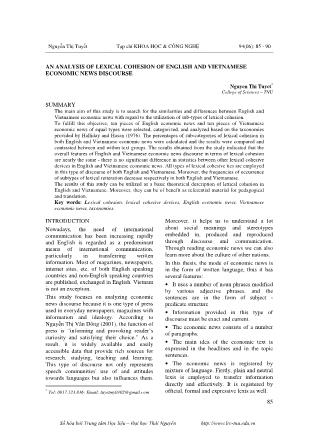
Nguyễn Thị Tuyết Tạp chí KHOA HỌC & CÔNG NGHỆ 94(06): 85 - 90 85 AN ANALYSIS OF LEXICAL COHESION OF ENGLISH AND VIETNAMESE ECONOMIC NEWS DISCOURSE Nguyen Thi Tuyet* College of Sciences – TNU SUMMARY The main aim of this study is to search for the similarities and differences between English and Vietnamese economic news with regard to the utilization of sub-types of lexical cohesion. To fulfill this objective, ten pieces of English economic news and ten pieces of Vietnamese economic news of equal types were selected, categorized, and analyzed based on the taxonomies provided by Halliday and Hasan (1976). The percentages of sub-categories of lexical cohesion in both English and Vietnamese economic news were calculated and the results were compared and contrasted between and within text groups. The results obtained from the study indicated that the overall features of English and Vietnamese economic news discourse in terms of lexical cohesion are nearly the same - there is no significant difference in statistics between other lexical cohesive devices in English and Vietnamese economic news. All types of lexical cohesive ties are employed in this type of discourse of both English and Vietnamese. Moreover, the frequencies of occurrence of subtypes of lexical reiteration decrease respectively in both English and Vietnamese. The results of this study can be utilized as a basic theoretical description of lexical cohesion in English and Vietnamese. Moreover, they can be of benefit as referential material for pedagogical and translation. Key words: Lexical cohesion, lexical cohesive devices, English economic news, Vietnamese economic news, taxonomies. INTRODUCTION* Nowadays, the need of international communication has been increasing rapidly and English is regarded as a predominant means of international communication, particularly in transferring written information. Most of magazines, newspapers, internet sites, etc. of both English speaking countries and non-English speaking countries are published, exchanged in English. Vietnam is not an exception. This study focuses on analyzing economic news discourse because it is one type of press used in everyday newspapers, magazines with information and idealogy. According to Nguyễn Thị Vân Đông (2001), the function of press is “informing and provoking reader’s curiosity and satisfying their choice.” As a result, it is widely available and easily accessible data that provide rich sources for research, studying, teaching and learning. This type of discourse not only represents speech communities' use of and attitudes towards languages but also influences them. * Tel: 0917.123.836; Email: tuyetmy0302@gmail.com Moreover, it helps us to understand a lot about social meanings and stereotypes embedded in, produced and reproduced through discourse and communication. Through reading economic news we can also learn more about the culture of other nations. In this thesis, the mode of economic news is in the form of written language, thus it has several features: • It uses a number of noun phrases modified by various adjective phrases, and the sentences are in the form of subject - predicate structure • Information provided in this type of discourse must be exact and current. • The economic news consists of a number of paragraphs. • The main idea of the economic text is expressed in the headlines and in the topic sentences. • The economic news is registered by mixture of language. Firstly, plain and neutral lexis is employed to transfer information directly and effectively. It is registered by official, formal and expressive lexis as well. Số hóa bởi Trung tâm Học liệu – Đại học Thái Nguyên Nguyễn Thị Tuyết Tạp chí KHOA HỌC & CÔNG NGHỆ 94(06): 85 - 90 86 • The tenor of the economic news is interpersonal between the writers and readers as they are working on the discourse. Coherence and cohesion in general and lexical cohesion in particular play such an important role in understanding economic news discourse due to their function of binding texts together by creating sequences of meaning. Lexical competence is indispensable part of communicative competence as it indicates the ability to use language in different contexts. According to Halliday and Hasan “A text is best regarded as a semantic unit: a unit not of form, but of meaning A text does not consist of sentences; it is realized by, or encoded in sentences”(Halliday﹠Hasan, 1976: 2). This means that a good article is not a patchwork of several sentences, but a cohesive unity linked by many cohesive ties. As a linguistic phenomenon, the lexical cohesion has been discussed by many linguists. Lexical cohesion was first discussed in terms of collocation by Firth (1957) and later studied seriously by Halliday & Hasan. Lexical cohesion is defined as “the cohesive effect achieved by the selection of vocabulary” (Halliday & Hasan, 1976:274). Halliday & Hasan’s viewpoint is shared by David Nunan (1993:28) when he stated that “lexical cohesion occurs when two words in a text are semantically related in some way.” Halliday & Hasan (1976) classified lexical cohesion into two main categories: reiteration and collocation. A reiteration may be a repetition, a synonym or near-synonym, a superordinate, or a general word. (1976:278). For Halliday & Hasan, superordinate and general word are considered as two separate categories. However, a general word is called general superordinate according to Mc. Carthy’s classification (1991:66). In this study, thus, superordinate and general words are treated under the heading superordinate. Halliday & Hasan (1976) also pointed out that the lexical relationship that features as cohesive force can be extended as there is cohesion between any pai ... other in some word- meaning relation. Therefore, this would include not only repetition, synonym/ near- synonym, and superordinate but also pairs of opposites which are put under the heading antonyms; or pairs of words indicating part to whole relation which is termed as meronymy, or part to part relation which is called co- meronymy In this paper, to be clarified, synonym/near- synonym will be treated under the heading synonym; any relations related to superordinate or meronym will be treated under the heading superordinate/ meronymy. Specifically, reiteration is divided into four subtypes, namely, repetition, synonym, antonym, superordinate/ meronymy. In order to analyse lexical cohesion of English and Vietnamese in economic news this research raises a question “What are the similarities and differences between the use of lexical cohesive devices in English and Vietnamese economic news discourse?” This research question will be clarified by three other sub-questions as follows: (i) How is lexical cohesion via lexical devices realized in English and Vietnamese economic news discourses? (ii) What are the most frequently used lexical cohesive devices in English and Vietnamese economic news discourses? (iii) What are the overall features of English and Vietnamese economic news discourse in terms of lexical cohesion? RESEARCH METHODS Research methods of description, analysis and statistics in linguistics have been used to fulfill the objectives of the study. Specifically, document analysis is the primary research method used in this study, which focuses on analysis of lexical cohesion in the economic news. Halliday and Hasan’s (1976) model is mainly adopted to identify lexical cohesive ties in the data. Yet, the definition and classification of lexical cohesive ties are carefully explained and illustrated. Số hóa bởi Trung tâm Học liệu – Đại học Thái Nguyên Nguyễn Thị Tuyết Tạp chí KHOA HỌC & CÔNG NGHỆ 94(06): 85 - 90 87 The data for the present analysis have been selected from mainstream newspapers written in English including Economics, Real Life Economics, The Times, Times online, The Sunday Times, The Wall Street Journal and Vietnamese such as Thời Báo Kinh Tế Việt Nam, Tiền Phong, Người Lao Động, Thanh niên, Kinh tế Tài chính và Thị trường Chứng khoán, The study uses a collection of ten pieces of English economic news and ten pieces of Vietnamese ones written by different journalists. All lexical cohesive ties in these news discourses are picked up, the types of lexical cohesive devices are noted. However, only outstanding examples are used to illustrate, the percentages of various type of lexical cohesion in each language are calculated and the results are compared and contrasted within and between text groups of the same genre in both English and Vietnamese. A COMPARISON OF LEXICAL COHESION OF ECONOMIC NEWS IN ENGLISH AND VIETNAMESE Frequency of occurrence of two major types of lexical cohesion The data reveal that in both English and Vietnamese economic news, reiteration is the more frequently occurring category of lexical cohesive ties with the percentage of contribution up to 88.5 in English and 89.8 in Vietnamese. Since reiteration is subcategorized into four types and the investigation of the random selected economic news in English and Vietnamese reveals that the four sub-types of reiteration do not occur with equal frequency. Therefore, the frequency of occurrence and the main features of each sub-type of reiteration ties will be discussed in detail in the next part. Table 1: Frequency of occurrence and percentage of contribution of two major types of lexical cohesion in English and Vietnamese economic news Lexical cohesive ties In English economic news In Vietnamese economic news Reiteration 524 (88.5%) 519 (89.8%) Collocation 68 (11.5%) 59 (10.2%) Total 592 (100%) 578 (100%) The sub-categories of lexical reiteration As shown in table 2, the distribution of different categories of lexical reiteration tie is roughly the same in English and Vietnamese economic news. Repetition is the most frequent lexical reiteration tie used in economic news discourse of both languages (73.7% in English and 80.3% in Vietnamese). However, among all types of reiteration, only repetition is used more frequently in Vietnamese economic news while all the other types are utilized more in English economic news Table 2: Frequency of occurrence and percentage of contribution of sub-categories of reiteration in English and Vietnamese economic news Sub-categories of reiteration ties in English economic news in Vietnamese economic news Repetition 386 (73.7%) 417 (80.3%) Synonym 74 (14.1%) 62 (11.9%) Antonym 33 (6.3%) 19 (3.7%) Superordinate/ Meronymy 31 (5.9%) 21 (4.1%) Total 524 (100%) 519(100%) Repitition Table 3: Frequency of occurrence and percentage of contribution of sub- categories of repetition Sub-categories of repetition in English economic news in Vietnamese economic news Simple lexical repetition 342 (88.6%) 406 (97.3%) Complex lexical repetition 44 (11.4%) 11 (2.7%) Total 386 (100%) 417 (100%) As presented in table 3, in both English and Vietnamese economic news, the number of simple lexical repetition is much higher than complex ones. However, simple lexical repetition is used more in Vietnamese economic news with the total number of appearance up to 406 (97.3%), whereas complex lexical repetition is employed more in English economic news at 44 (11.4%). Số hóa bởi Trung tâm Học liệu – Đại học Thái Nguyên Nguyễn Thị Tuyết Tạp chí KHOA HỌC & CÔNG NGHỆ 94(06): 85 - 90 88 The investigation result indicates that the most natural and common simple lexical repetition in both English and Vietnamese economic news is repetition of nouns or noun phrases. Synonym The result of the survey shows that the number of synonym is a bit higher in English economic news than in Vietnamese ones. Synonyms can be nouns, verbs, or adjectives. Antonym The data in table 4 indicates that the total number of antonym in English economic news is higher than that in Vietnamese ones. Among these types, the contrary relation and ordered series occur more frequently in English than in Vietnamese economic news. Hardly any complementary relation is found in economic news of both languages. Table 4: Frequency of occurrence and percentage of contribution of subtypes of antonym Subtypes of antonym In English economic news In Vietnamese economic news Contrary relation 15 (45.4%) 10 (52.6%) Complementary relation 0 (0%) 1 (5.2%) Relational opposite 4 (12.1%) 4 (21.1%) Ordered series 14 (42.5%) 4 (21.1%) Total 33 (100%) 19 (100%) Superordinate/ Meronymy As presented in table 2, superordinate/ meronymy are of the smallest proportion among other types of reiteration accounting for only 5.9% in English and 4.1% in Vietnamese economic news. Collocation There are three subtypes of lexical collocation: resultative collocation, modificational collocation, and contextual collocation (cited in Hoàng Văn Vân: 2006:84) As shown in table 1 and table 5, the total number of collocation in English economic news (68) is a bit higher than that in Vietnamese ones (59). Specifically, resultative collocation accounts for only small portion (5.9% in English and 3.4% in Vietnamese economic news) among three types. Modificational collocations occur more frequently in English economic news (53%), whereas contextual collocation appears more often in Vietnamese economic news (67.8%). Table 5: Frequency of occurrence and percentage of contribution of subtypes of lexical collocation Subtypes of lexical collocation in English economic news in Vietnamese economic news Resultative collocation 4 (5.9%) 2 (3.4%) Modificational collocation 36 (53%) 17 (28.8%) Contextual collocation 28 (41.1%) 40 (67.8%) Total 68 (100%) 59 (100%) CONCLUSIONS The results taken from the study of both English and Vietnamese economic news give the answers for all the questions mentioned previously. The following concluding remarks give the answer for the first question: - All types of lexical cohesive ties are utilized in both English and Vietnamese economic news. - The densities of English and Vietnamese economic news regarding to the utilization of lexical cohesive devices are nearly the same. - The differences between other forms of lexical cohesive types are not statistically significant. - In both English and Vietnamese economic news discourses, the percentage of occurrence of subcategories of lexical reiteration ties decrease respectively. For the second question, the result indicates that there is a general tendency in using repetition in both English and Vietnamese economic news. Obviously, this is the most popular form of lexical reiteration in both languages. Số hóa bởi Trung tâm Học liệu – Đại học Thái Nguyên Nguyễn Thị Tuyết Tạp chí KHOA HỌC & CÔNG NGHỆ 94(06): 85 - 90 89 The investigation also reveals that the overall features of English and Vietnamese economic news discourse in terms of lexical cohesion are nearly the same. The last and also the different characteristic between English and Vietnamese economic news is that in English the role of reference item, typically ‘the’ or the demonstratives ‘this’, ‘that’, ‘these’, ‘those’ are emphasized. Whereas, in Vietnamese, sometimes these reference items can be omitted without losing the cohesive force. RECOMMENDATIONS This study would suggest that the high proportion of similarities in lexical cohesive ties use between English and Vietnamese economic news are elements to be positively exploited. 1. Implications for teaching and learning ESP With the primary aim to equip students with academic knowledge and social knowledge, the designing and developing of ESP reading material is a very essential task for every ESP teacher. Using economic news as teaching and learning materials for ESP teachers and learners is a good idea to help to improve their own skills. 2. Implications for teaching and learning translation Of the lexical cohesive devices employed in both English and Vietnamese economic news, collocations should receive the central attention in translation. Obviously, collocations occur quite often in English and Vietnamese economic news. However, learning collocations is not an easy task as it is such a diverse subject. The learner’s task is then to recognize the possibility of certain words which tend to occur together. It is advisable for the learners to raise their awareness of collocations in translating. This will enable them to avoid word-for-word translation and foster their awareness of the linguistic convention of collocations. REFERENCES [1]. Brown, G and Yule, G. (1983). Discourse Analysis. Cambridge: CUP [2]. Dong, Nguyen Thi Van. (2001) A Study of Socio-Cultural Headlines in English Press. Unpublished M.A thesis. Hanoi. [3]. Halliday, M.A.K & Hasan, R. (1976) Cohesion in English. London: Longman [4]. Hasan, R. (1984) Coherence and Cohesive Harmony. London: Longman. [5]. Hill, J. and Lewis.M, (1997) LTP Dictionary of Selected Collocations. Hove: Language Teaching Publications. [6]. McCarthy, M. (1992). Discourse analysis for language teachers. New York: Cambridge University Press. [7]. Swales, J.M. (1990) Genre Analysis. Cambridge: Cambridge University Press. [8]. Ban, Diep Quang (1990) Văn bản và liên kết trong Tiếng Việt (Tái bản lần thứ nhất). Nxb Giáo dục. [9]. Them, Tran Ngoc. (1985) Hệ thống Liên kết Văn bản Tiếng Việt. Hà Nội: Nxb Khoa học Xã hội. Số hóa bởi Trung tâm Học liệu – Đại học Thái Nguyên Nguyễn Thị Tuyết Tạp chí KHOA HỌC & CÔNG NGHỆ 94(06): 85 - 90 90 TÓM TẮT PHÂN TÍCH CÁC PHƯƠNG TIỆN LIÊN KẾT TỪ VỰNG TRONG DIỄN NGÔN TIN KINH TẾ TIẾNG ANH VÀ TIẾNG VIỆT Nguyễn Thị Tuyết* Trường Đại học Khoa học – ĐH Thái Nguyên Mục đích chính của nghiên cứu này là tìm ra những điểm tương đồng và khác biệt trong việc sử dụng các phương tiện liên kết từ vựng trong diễn ngôn tin kinh tế Tiếng Anh và Tiếng Việt. Để thực hiện mục tiêu này, mười diễn ngôn tin tức kinh tế Tiếng Anh và mười diễn ngôn tin tức kinh tế Tiếng Việt cùng loại được lựa chọn, phân loại, và phân tích dựa trên các nguyên tắc phân loại của Halliday và Hasan (1976). Tỷ lệ các loại liên kết từ vựng trong cả diễn ngôn tin kinh tế tiếng Anh và Tiếng Việt được tính toán, kết quả được so sánh và đối chiếu giữa và trong cùng nhóm văn bản. Các kết quả thu được từ nghiên cứu này chỉ ra rằng các phương tiện liên kết từ vựng trong diễn ngôn tin kinh tế Tiếng Anh và Tiếng Việt nhìn chung khá tương đồng - không có sự khác biệt đáng kể nào. Tất cả các loại phương tiện liên kết từ vựng đều được sử dụng trong cả diễn ngôn tin kinh tế Tiếng Anh và Tiếng Việt. Bên cạnh đó, mức độ sử dụng các phép lặp từ vựng giảm tương ứng trong cả hai ngôn ngữ. Kết quả của nghiên cứu này có thể được sử dụng như một tiền đề mô tả lý thuyết cơ bản về liên kết từ vựng trong diễn ngôn tin kinh tế Tiếng Anh và Tiếng Việt. Hơn nữa, chúng có thể được xem như nguồn tài liệu tham khảo cho việc giảng dạy và dịch thuật. Từ khóa: Liên kết từ vựng, phương tiện liên kết từ vựng, tin kinh tế Tiếng Anh, tin kinh tế Tiếng Việt, nguyên tắc phân loại Ngày nhận: 28/04/2012; Ngày phản biện:28/05/2012; Ngày duyệt đăng:12/06/2012 * Tel: 0917.123.836; Email: tuyetmy0302@gmail.com Số hóa bởi Trung tâm Học liệu – Đại học Thái Nguyên
File đính kèm:
 an_analysis_of_lexical_cohesion_of_english_and_vietnamese_ec.pdf
an_analysis_of_lexical_cohesion_of_english_and_vietnamese_ec.pdf

